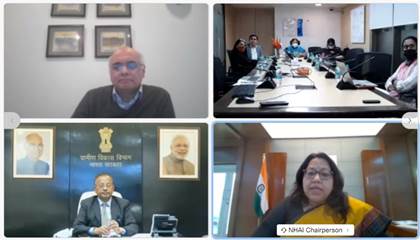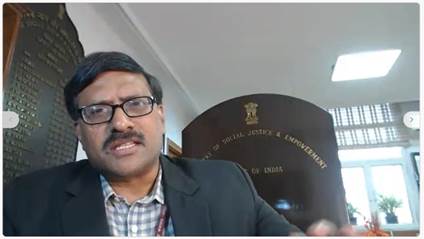The Ministry of Rural Development’s Deendayal Antyodaya Yojana-National Rural Livelihoods Mission (DAY-NRLM) and the World Bank organized a virtual learning event on 24 February 2022 on how to integrate ultra-poor women into the Mission’s programs. The learning session comprised presentations by BRAC and BOMA, organizations that have successfully piloted ultra-poor programs in many countries, as well as Bihar’s State Rural Livelihood Mission and was attended by over 6000 participants from across 34 States and Union Territories in India.
Senior officials from the Ministry of Rural Development, including Mr. Nagendra Nath Sinha, Secretary, Rural Development and the World Bank’s Country Director for India, Mr. Junaid Kamal Ahmad presided over the event. The learning session included a special address by Mr. R. Subrahmanyam, Secretary, Ministry of Social Justice and Empowerment.

India’s DAY-NRLM is one of the largest community mobilization efforts in the world, organizing more than 80 million poor women into over 7.4 million self-help groups – building their savings, promoting sustainable livelihoods, but above all enhancing their empowerment. Special emphasis is given particularly to women from vulnerable communities such as manual scavengers, victims of human trafficking, Particularly Vulnerable Tribal Groups (PVTGs), and Persons with Disabilities (PwDs). Yet, many women from the poorest households continue to face challenges to joining groups, sustaining savings and building their livelihoods. The learning event focused on lessons from programs like BRAC and BOMA that have worked with such ‘ultra-poor’ households by using holistic, time-bound and a sequenced set of interventions, enabling them to earn a basic minimum amount to progress along a pathway to sustainable livelihoods and socioeconomic resilience.

Shri Sinha recognized the need for having clear definitions for identifying and targeting women who face additional vulnerabilities because of their identity and circumstances. He added, “We need better bottom-up targeting to narrow our focus on these poorest women, give them small grants and assets, and some handholding through trainings and links to markets, before they can reach a minimum threshold to join groups and avail their entitlements.”

Shri Subrahmanyam too stated that women with special needs such as tribal widows the elderly and destitute needed special attention underlined a need for a defined strategy for the ultra poor under DAY-NRLM.
Shri Junaid Kamal Ahmad added, “The World Bank has had a long relationship with NRLM. This partnership, through state-level rural livelihood missions (SRLMs) in Bihar, Andhra Pradesh and Tamil Nadu, has helped lift millions of households out of poverty. The goal is, however, even more ambitious – that of universal coverage. Women are often unable to take advantage of such missions – as they belong to socially excluded groups or live in isolated hamlets. The World Bank, in partnership with the States, is committed to ensuring that livelihood opportunities can be accessed by all women seeking to engage in the labor market”.
Setting the context for the Webinar, Mrs. Nita Kejrewal, Joint Secretary, MoRD stated that a special strategy is required to bring the poorest of poor households in the rural areas under DAY-NRLM and support them for a better quality of life. She said the webinar was aimed at bringing both domestic and international experiences to help design a suitable strategy for coverage of the ultra-poor under the Mission.
The discussion comprised presentations by two international organizations working on targeting ultra-poor households. Mr. Palash Das, Director, Ultra Poor Graduation Initiative, BRAC presented the approach BRAC has adopted starting from Bangladesh and spreading to 50 other countries to identify the extreme poor, supporting their immediate requirements, their skills, assets and enterprises and building their savings. The program has reached nearly 14 million people in the past 20 years, and 95 percent have moved out of extreme poverty.
Ms. Jaya Tiwari, Vice President and Chief Impact Officer BOMA, spoke about how their organization has reached more than 350,000 women and children living in extreme poverty in six countries in the African dry lands by experimenting with peer based and group learning approaches to build resilience among the most vulnerable.
Mr. Balamurugan, CEO,Jeevika (Bihar), outlined the approach adopted by the program to reach more than 100,000 vulnerable Scheduled Caste and Scheduled Tribe households in the state who do not have the ability or face complex social norms to joining groups.
In the discussion that followed, Ms. Alka Upadhyaya, ex-Additional Secretary, Rural Development and Chairperson, National Highways Authority of India urged NRLM to scale up strategies to expand its membership base. She added, “Sometimes you need an additional push to force open the poverty traps women live in. Dalit and Adivasi women may not be able to join self-help groups because of social norms in a village. They may not be able to meet even the basic savings criteria or may be dealing with day-to-day food insecurity. I hope this learning event helps NRLM and states devise an operational approach to reach such women.”
Ms. Anna O’ Donnell, Lead Social Development Specialist, Social Sustainability and Inclusion, South Asia, World Bank, the second discussant of the webinar, shared that the rapid reduction in poverty is possible with around 18-24 months of intensive and well sequenced assistance to ultra-poor households supported with convergence with all programmes. The flexible and adaptive design of programme while maintaining the core essence of the model would be more effective in a country like India with a wide range of context. The use of technology in the model can help integrating the learning and adaption in the model with pace.
In his concluding remarks, Mr. Kevin Tomlinson, Practice Manager, Social Sustainability and Inclusion, World Bank added: “Close to 100 to 150 million in India live below $1.90 per day, a number that may have risen after COVID. These people face a multitude of interconnected challenges, which often overlap with their social identities. They have little or no productive assets and are often excluded from social services. Women, as we know, face additional barriers. I hope the presentations made today have given the Ministry some thought on how to develop and scale up an approach to reach women who are in the most vulnerable situations”.
*****
APS/JK


